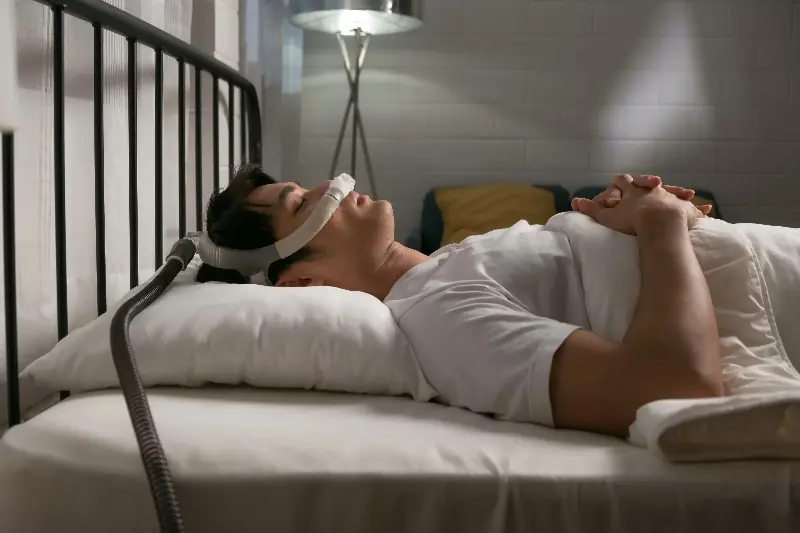
The ancient practice of blowing through a conch shell could help to reduce dangerous symptoms of obstructive sleep apnea (OSA)—offering an alternative to medication and machines.
People with a moderate form of the snoring condition who practice the method—also known as shankh blowing—were found to feel more alert during the day and have fewer breathing interruptions at night, according to a small but promising trial.
"Shankh blowing is a traditional practice in Indian culture, often used in religious rituals and yoga. It symbolizes auspiciousness and is believed to purify the environment," Dr. Krishna K Sharma, study author of the Eternal Heart Care Centre and Research Institute in India, told Newsweek.
This is thought to date back to around 1,000 BCE, with conch shells (belonging to sea snails) typically large and spiraled.
"Yogic texts also describe it as a breathing exercise that strengthens the lungs and throat," added Sharma.
OSA is a common sleep disorder—affecting around 30 million Americans—with which breathing repeatedly stops during the night as a result of blocked airways.
The condition leads to loud snoring, restless sleep, daytime sleepiness and increases the risk of high blood pressure, heart disease and stroke.
Conch blowing may represent a surprising yet simple, comfortable and low-cost intervention to help people with OSA.
"In our clinical practice, several patients reported sleeping better and feeling less fatigued after regularly blowing a conch shell. One even improved on a sleep study without continuous positive airway pressure [CPAP, a current treatment device]," explained Sharma.
"These experiences inspired us to test this ancient yogic breathing technique through a formal clinical trial."
The study assessed 30 people with moderate OSA, aged between 19 and 65, in the period between May 2022 and January 2024. They were tested with polysomnography, which means they were monitored throughout a night's sleep and then asked questions about the quality of their sleep and how sleepy they felt during the day.
The participants were randomly assigned to either be trained to practice blowing through a conch shell (16 patients) or to practice a deep breathing exercise (14 patients).
Both groups were trained trained in person at the clinic by a study team member before beginning home-based practice—with the conch-blowing participants provided with a traditional shankh used in yogic practices.
Participants were encouraged to practice at home for a minimum of 15 minutes, five days per week. They were reassessed after six months.
Compared to those who practiced deep breathing, the people who took part in the shankh blowing were 34 percent less sleepy during the daytime, reported sleeping better and the polysomnography test revealed they had four to five fewer apneas (where breathing stops during sleep) per hour on average. They also had higher levels of oxygen in their blood during the night.
The outcomes among the conch blowers were significantly better than the control group who did deep breathing, according to the researchers.
"Shankh blowing involves deep inhalation and forceful exhalation through pursed lips, creating vibrations and resistance. This likely tones upper airway muscles (like the soft palate and throat), helping keep the airway open during sleep. Its unique spiraled structure might also enhance acoustic and mechanical stimulation," Sharma explained.
"CPAP is the gold standard, but many struggle with comfort and long-term use. Shankh blowing is not a replacement but could be an adjunct or alternative—especially for those with mild-to-moderate OSA, or in settings where CPAP is inaccessible or unaffordable."
While sleep apnea can sometimes be treated through lifestyle changes like losing weight, giving up smoking and reducing alcohol intake, many people have to use CPAP.
This involves a machine gently pumping air into a mask over their mouth or nose while sleeping. While effective, some people may find it uncomfortable or struggle to use it consistently.
"The conch shell's resistance and vibratory effects could potentially be mimicked in a medical device designed for airway muscle training. This is an area for future exploration," said Sharma.
However, he added, "Because the conch is already widely available [depending on location] and safe, motivated patients could begin using it under guidance. With more research, it could become a validated, low-cost tool to support sleep apnea care—especially in underserved communities or where CPAP access is limited."
While the researchers have already received ethical approval for a larger multicenter trial in India, future research will assess how shankh blowing affects airway muscle tone, oxygenation and sleep architecture over time, as well as how it compares directly to CPAP.
"This is an intriguing study that shows the ancient practice of shankh blowing could potentially offer an OSA treatment for selected patients by targeting muscle training," professor Sophia Schiza—head of the European Respiratory Society's group on sleep disordered breathing in Greece—said in a statement.
"A larger study will help provide more evidence for this intervention, which could be of benefit as a treatment option or in combination with other treatments in selected OSA patients."
Do you have a tip on a health story that Newsweek should be covering? Do you have a question about sleep apnea? Let us know via [email protected].
Reference
Sharma, K. K., Gupta, R., Choyal, T., Sharma, K. K., Sharma, D., & Sharma, T. (2025). Efficacy of blowing shankh on moderate sleep apnea: A randomised control trial. ERJ Open Research. https://doi.org/10.1183/23120541.00258-2025
Related Articles
- Rapamycin's Effects on Human Aging Explored in New Study
- Drug Could Stop Life-Threatening Food Allergies in Millions
- Alzheimer's: Scientists Reveal Diet That May Stave Off Disease
- Alzheimer's: Scientists Discover What Sparks Disease
